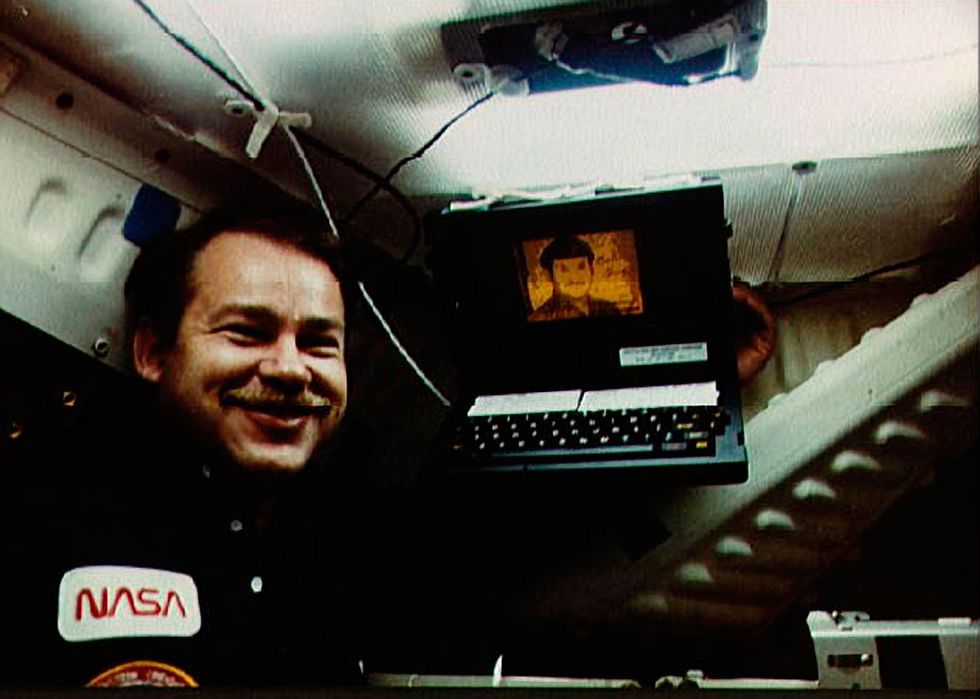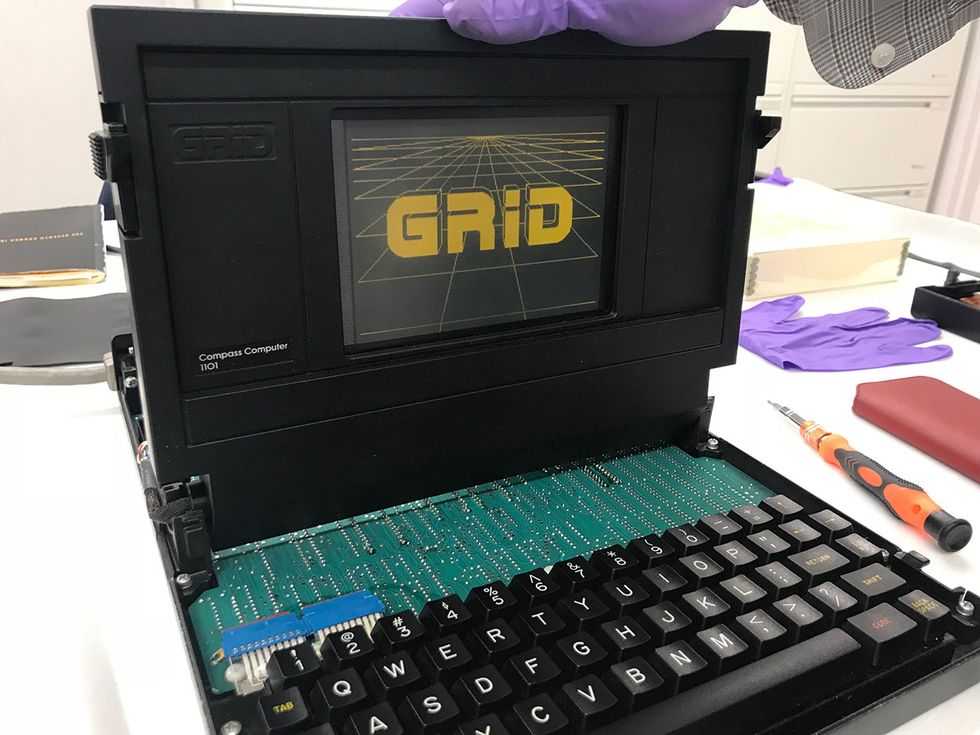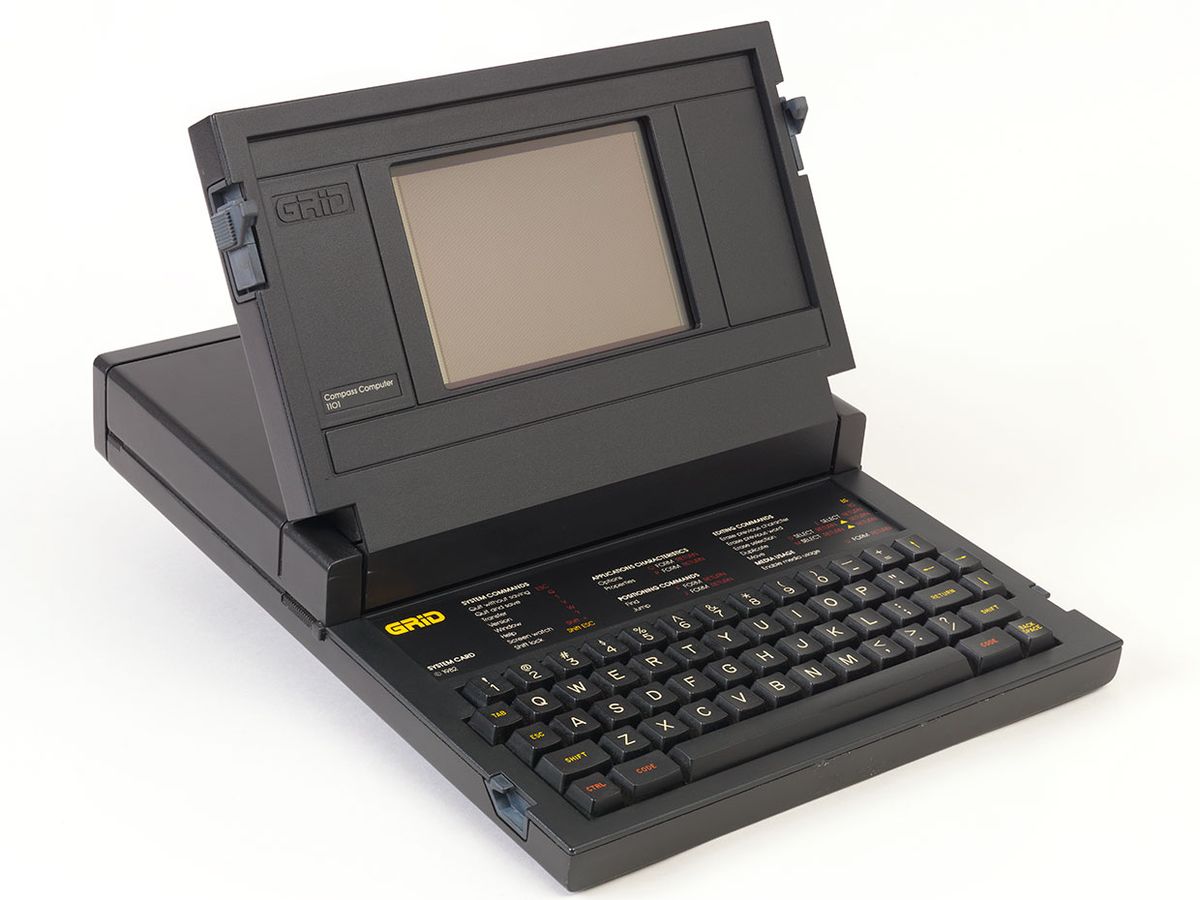The year 1982 was a notable one in personal computing. The BBC Micro was introduced in the United Kingdom, as was the Sinclair ZX Spectrum. The Commodore 64 came to market in the United States. And then there was the GRiD Compass.
The GRiD Compass Was the First Laptop to Feature a Clamshell Design
The Graphical Retrieval Information Display (GRiD) Compass had a unique clamshell design, in which the monitor folded down over the keyboard. Its 21.6-centimer plasma screen could display 25 lines of up to 128 characters in a high-contrast amber that the company claimed could be “viewed from any angle and under any lighting conditions.”
By today’s standards, the GRiD was a bulky beast of a machine. About the size of a large three-ring binder, it weighed 4.5 kilograms (10 pounds). But compared with, say, the Osborne 1 or the Compaq Portable, both of which had a heavier CRT screen and tipped the scales at 10.7 kg and 13 kg, respectively, the Compass was feather light. Some people call the Compass the first truly portable laptop computer.
The computer had 384 kilobytes of nonvolatile bubble memory, a magnetic storage system that showed promise in the 1970s and ’80s. With no rotating disks or moving parts, solid-state bubble memory worked well in settings where a laptop might, say, take a tumble. Indeed, sales representatives claimed they would drop the computer in front of prospective buyers to show off its durability.
But bubble memory also tends to run hot, so the exterior case was designed out of a magnesium alloy to make it a heat sink. The metal case added to the laptop’s reputation for ruggedness. The Compass also included a 16-bit 8086 microprocessor and up to 512 KB of RAM. Floppy drives and hard disks were available as peripherals.
With a price tag of US $8,150 (about $23,000 today), the Compass wasn’t intended for consumers but rather for business executives. Accordingly, it came preloaded with a text editor, a spreadsheet, a plotter, a terminal emulator, a database management system, and other business software. The built-in 1200-baud modem was designed to connect to a central computer at the GRiD Systems’ headquarters in Mountain View, Calif., from which additional applications could be downloaded.
The GRiD’s Sturdy Design Made It Ideal for Space
The rugged laptop soon found a home with NASA and the U.S. military, both of which valued its sturdy design and didn’t blink at the cost.
The first GRiD Compass launched into space on 28 November 1983 aboard the space shuttle Columbia. The hardware adaptations for microgravity were relatively minor: a new cord to plug into the shuttle’s power supply and a small fan to compensate for the lack of convective cooling in space.

The software modifications were more significant. Special graphical software displayed the orbiter’s position relative to Earth and the line of daylight/darkness. Astronauts used the feature to plan upcoming photo shoots of specific locations. The GRiD also featured a backup reentry program, just in case all of the IBMs at Mission Control failed.
For its maiden voyage, the laptop received the code name SPOC (short for Shuttle Portable On-Board Computer). Neither NASA nor GRiD Systems officially connected the acronym to a certain pointy-eared Vulcan on Star Trek, but the GRiD Compass became a Hollywood staple whenever a character had to show off wealth and tech savviness. The Compass featured prominently in Aliens, Wall Street, and Pulp Fiction.
The Compass/SPOC remained a regular on shuttle missions into the early 1990s. NASA’s trust in the computer was not misplaced: Reportedly, the GRiD flying aboard Challenger survived the January 1986 crash.
The GRiDPad 1900 Was a First in Tablet Computing
John Ellenby and Glenn Edens, both from Xerox PARC, and David Paulson had founded GRiD Systems Corp. in 1979. The company went public in 1981, and the following year they launched the GRiD Compass.
Not a company to rest on its laurels, GRiD continued to be a pioneer in portable computers, especially thanks to the work of Jeff Hawkins. He joined the company in 1982, left for school in 1986, and returned as vice president of research. At GRiD, Hawkins led the development of a pen- or stylus-based computer. In 1989, this work culminated in the GRiDPad 1900, often regarded as the first commercially successful tablet computer. Hawkins went on to invent the PalmPilot and Treo, though not at GRiD.
Amid the rapidly consolidating personal computer industry, GRiD Systems was bought by Tandy Corp. in 1988 as a wholly owned subsidiary. Five years later, GRiD was bought again, by Irvine, Calif.–based AST Research, which was itself acquired by Samsung in 1996.
In 2006 the Computer History Museum sponsored a roundtable discussion by key members of the original GRiD engineering team: Glenn Edens, Carol Hankins, Craig Mathias, and Dave Paulson, moderated by New York Times journalist (and former GRiD employee) John Markoff:
How Do You Preserve an Old Computer?
Although the GRiD Compass’s tenure as a computer product was relatively short, its life as a historic artifact goes on. To be added to a museum collection, an object must be pioneering, iconic, or historic. The GRiD Compass is all three, which is how the computer found its way into the permanent holdings of not one, but two separate Smithsonian museums.
One Compass was acquired by the National Air and Space Museum in 1989. No surprise there, seeing as how the Compass was the first laptop used in space aboard a NASA mission. Seven years later, curators at the Cooper Hewitt, Smithsonian Design Museum added one to their collections in recognition of the innovative clamshell design.
Credit for the GRiD Compass’s iconic look and feel goes to the British designer Bill Moggridge. His firm was initially tasked with designing the exterior case for the new computer. After taking a prototype home and trying to use it, Moggridge realized he needed to create a design that unified the user, the object, and the software. It was a key moment in the development of computer-human interactive design. In 2010, Moggridge became the fourth director of the Cooper Hewitt and its first director without a background as a museum professional.
Considering the importance Moggridge placed on interactive design, it’s fitting that preservation of the GRiD laptop was overseen by the museum’s Digital Collection Materials Project. The project, launched in 2017, aims to develop standards, practices, and strategies for preserving digital materials, including personal electronics, computers, mobile devices, media players, and born-digital products.
Keeping an electronic device in working order can be extremely challenging in an age of planned obsolescence. Cooper Hewitt brought in Ben Fino-Radin, a media archeologist and digital conservator, to help resurrect their moribund GRiD. Fino-Radin in turn reached out to Ian Finder, a passionate collector and restorer of vintage computers who has a particular expertise in restoring GRiD Compass laptops. Using bubble memory from Finder’s personal collection, curators at Cooper Hewitt were able to boot the museum’s GRiD and to document the software for their research collections.

Even as museums strive to preserve their old GRiDs, new GRiDs are being born. Back in 1993, former GRiD employees in the United Kingdom formed GRiD Defence Systems during a management buyout. The London-based company continues the GRiD tradition of building rugged military computers. The company’s GRiDCASE 1510 Rugged Laptop, a portable device with a 14.2-cm backlit LED display, looks remarkably like a smaller version of the Compass circa 1982. I guess when you have a winning combination, you stick with it.
An abridged version of this article appears in the June 2020 print issue as “The First Laptop in Orbit.”
Part of a continuing series looking at photographs of historical artifacts that embrace the boundless potential of technology.
About the Author
Allison Marsh is an associate professor of history at the University of South Carolina and codirector of the university’s Ann Johnson Institute for Science, Technology & Society.
Allison Marsh is a professor in Women and Gender Studies at the University of South Carolina and codirector of the university’s Ann Johnson Institute for Science, Technology & Society. She combines her interests in engineering, history, and museum objects to write the Past Forward column, which tells the story of technology through historical artifacts. Marsh is currently working on a book on the history of women in electrical engineering.



